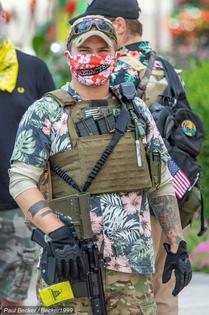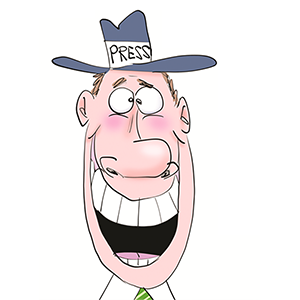Patriots’ Day: How far-right groups hijack history and patriotic symbols to advance their cause, according to an expert on extremism
Published in News & Features
Patriots’ Day, a commemoration of the battles of Lexington and Concord – the first confrontations of the American Revolution – holds historical value as a symbol of American resistance to British colonial rule. Over time, however, the holiday has been co-opted by extremist groups.
Capitalizing on ambiguities in the understanding of patriotic symbols, extremist groups have attempted to change the meaning of freedom and liberty embedded in the symbol of the American flag.
Not all states celebrate Patriots’ Day. Massachusetts and Maine observe it as a public holiday on the third Monday in April. Wisconsin observes Patriots’ Day as a state observance – not a public holiday – on April 19, with schools and businesses remaining open. Other states may also mark it informally or through educational activities.
As a scholar of extremism, I have become increasingly concerned by the appropriation of patriotic symbols such as the American flag and Patriots’ Day into narratives for far-right rhetoric, recruitment and radicalization. Patriotic events such as the Fourth of July can be marked by demonstrations, armed protests and calls for militant action by far-right extremist groups.
Just before the Fourth of July in 2019, the Southern Poverty Law Center demonstrated how extremist groups have long adopted symbols of U.S. history to promote white supremacy. A 2010 SPLC report documented extremist calls for “freedom,” including a call from such far-right groups for repeal of all social service spending.
The hijacking of patriotic symbols is part of an effort to create an atmosphere where participants believe they are engaging in a modern-day fight for freedom.
In interviews I conducted with extremists in March 2025, several members of the Patriot Front said they are planning to protest on April 19 in an effort to use the holiday to attract media and public attention to their efforts to create a white homeland.
Extremists are not the only Americans who are planning on using Patriots’ Day as a platform to attract attention to their causes. Mobilization of opposition to President Donald Trump’s policies and deportation efforts are also planned for April 19. Protesters raise concerns about the incorporation of American patriotic symbols by the right wing to support policies that they view as distinctively anti-American and unconstitutional.
The 250th anniversary on April 19 of the first battles of the American Revolution is a fitting time to reflect on the meaning and use of historical symbols.
From a sociological perspective, national symbols and events such as the American flag and Patriots’ Day do not have fixed meanings. Rather, any symbol is defined by how people actually use it. Whether one raises an American flag or burns one, the use of the flag is a powerful symbol that is understood to mean different things to different people, depending on the context.
Extremists often take other symbols of American patriotism, such as the bald eagle, the Second Amendment and the phrase “America the beautiful” and try to use them to promote their message. For example, white supremacists believe that America can be beautiful only if white Americans are in positions of authority. The interpretations of these symbols become tools for extremist mobilization.
In the lead-up to Patriots’ Day in 2023, members of the Patriot Front, a white supremacist group, rallied near the Massachusetts State House in Boston. They displayed a banner reading “Reclaim America,” a slogan associated with their ideology.
Several white supremacist groups such as the Patriot Front, National Socialist Club-131 and other neo-Nazis groups position themselves as authentic modern-day “patriots” fighting to preserve society. They claim they are “undermined by a government that represses citizens” and creates an unsafe space for what they call a “white homeland.”
The Patriot Front manifesto, written by group founder Thomas Rousseau, states: “A nation within a nation is our goal. Our people face complete annihilation as our culture and heritage are attacked from all sides.”
The extremist groups see Patriots’ Day not only as a commemoration of resistance against British colonialism but as a rallying point for a radical vision of American identity that attracts more attention from the public and the media because of the use of the recognized symbol.
Extremists frame their actions as a continuation of the American Revolution and draw upon the myth of an oppressed, virtuous “true American” standing against tyranny. In this view, traditional symbols of American patriotism represent resistance not against an overarching foreign power but against internal threats to their vision of America.
These include perceived threats posed by progressive movements, racial minorities, immigrants and the federal government. In the minds of those on the far right, what’s at stake are their traditional values, gun ownership and individual rights.
The Southern Poverty Law Center has highlighted the significance of April 19 in the anti-government “patriot” movement’s calendar, noting that it has been associated with increased activity from militias and other extremist groups.
Some of those groups include the sovereign citizens movement, Boogaloo Bois and the Patriot Front. The sovereign citizen movement is a loosely organized group of individuals who believe that they are not subject to government laws, especially federal laws in the United States. The Boogaloo movement is an anti-government extremist group known for advocating for a second American civil war, which they often call the “boogaloo.”
The construction of the “true American” is central to the ideology. For many far-right groups, the “true” or “real” American is defined as someone who believes in the preservation of a specific, often exclusionary version of American values in which white Americans are seen as both moral paragons and under siege.
Some American militia groups, such as the Oath Keepers and Three Percenters, claim that only those willing to resist their idea of “tyranny” are true American patriots and that they should resist the government.
In 2014, the Oath Keepers participated in an armed standoff in Nevada to support rancher Cliven Bundy, who was in a dispute with the Bureau of Land Management over unpaid grazing fees. The group positioned themselves as defenders against federal authority. Two men with ties to the Three Percenters, Barry Croft and Adam Fox, were involved in a plot to kidnap Michigan Gov. Gretchen Whitmer in 2020. The plot was foiled by law enforcement, and the individuals were arrested and charged with terrorism-related offenses. Both received lengthy prison sentences.
As Stewart Rhodes, who founded The Oath Keepers in 2009 in Lexington, Massachusetts, has said: “We are the last line of defense against tyranny. Real patriots will stand up.”
Anyone not aligned with their ideology is seen as a traitor or unwilling to confront systemic problems and are derisively labeled “sheep.”
One of the most concerning ways in which American patriotic symbols are co-opted by extremists is the potential to justify violent action.
The connection between historical acts of violence, such as the battles of Lexington and Concord, and contemporary calls for preparation for violent actions is deliberately emphasized. According to historian Darren Mulloy, extremists use well-known and accepted American symbols to create a sense that violence is a justified and necessary means of defense. Militia groups, in Mulloy’s research, exploit the need for violence in the American Revolution and the settling of the American West to legitimize their contemporary calls.
The Oath Keepers romanticize the role of armed militias in the founding of America as seen at Lexington and Concord. They use this day to promote the idea that their cause is just and that armed resistance is a legitimate form of political expression.
Groups such as The Base and the Oath Keepers have called for training in preparation for armed defense against the government. They recruit current and former military, police and first responders, urging them to uphold an oath to defend the Constitution – as the group interprets it – often against what they see as a tyrannical federal government.
This creates a dangerous feedback loop in which extremism and violence are normalized through the glorification of historical events that celebrate acts of rebellion while strengthening identities that radicalize individuals.
Understanding how patriotic symbols can be exploited offers important insights into how historical narratives may be manipulated, potentially leading to harmful consequences in American society.
This article is republished from The Conversation, a nonprofit, independent news organization bringing you facts and trustworthy analysis to help you make sense of our complex world. It was written by: Art Jipson, University of Dayton
Read more:
Is backing independence the same as being a nationalist? Not necessarily
Former Oath Keeper reveals racist, antisemitic beliefs of white nationalist group – and their plans to start a civil war
Protestantism’s troubling history with white supremacy in the US
Art Jipson does not work for, consult, own shares in or receive funding from any company or organization that would benefit from this article, and has disclosed no relevant affiliations beyond their academic appointment.















Comments